Part 1 - General
By Gordon Penner, FAA Gold Seal Instructor, 3-time MCFI-Aerobatic, SAFE Member
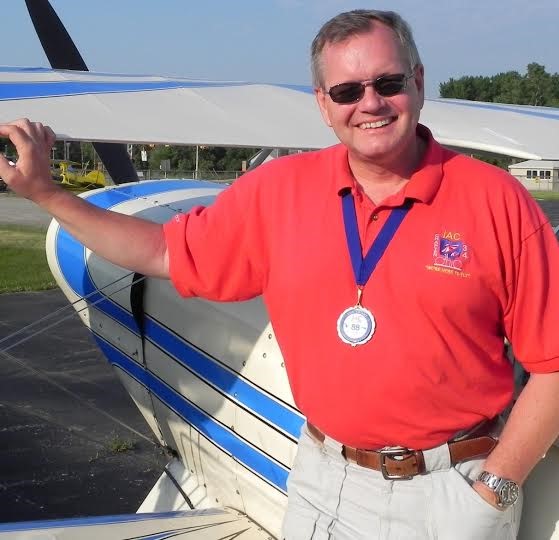
The FAA is deep into a continuing effort to stem the Loss of Control-Inflight, or LOC-I, accidents. These are primarily maneuvering, meaning turning and coordinating, accidents . They have made some inroads, but it is hard to turn a battleship. Within this last decade Rich Stowell, of Emergency Maneuver Training (EMT) fame, and other experts have been working with the FAA to more closely define the problem, and to even review how we teach flying.
Famed tailwheel and aerobatic instructor Greg Koontz's great article, "Three Dimensional Thinking" in the May 2020 issue of Sport Aerobatics magazine, talked insightfully about how we need to improve our knowledge about flying. This series of articles touches on that, but will mostly address the decision making portion of accident awareness and avoidance. Remember, it is good to have the skill and to be able to win a knife fight, but the best way to win a knife fight is to never be in one.
Part 1 of this series will be primarily about LOC-I and Decision Making in general. Part 2 will discuss the Takeoff phase, from the beginning of the takeoff roll to the point where a safe return altitude is reached. Part 3 will discuss LOC-I when trying to return to the runway after engine failure, and ways to determine a safe return altitude. Part 4 will be about LOC-I in the maneuvering, approach, and landing phases. Part 5 is about botched Go-Arounds.
The Experimental Aircraft Association (EAA) and the International Aerobatic Club (IAC) have long championed bringing back the maneuvering skills taught in the 1930’s Tex Rankin system and the 1940’s WWII military training system. But overall, we pilots as a group, especially those pilots ‘raised’ outside of the tailwheel or glider communities, still have way too many maneuvering accidents.
By maneuvering we generally mean takeoff, pattern, landing, and go around operations, as well as maneuvering around ground objects and inflight upsets. Some of the problem comes from lack of knowledge about maneuvering, brought about by how we were taught.
Flying is not like driving a car. Rich Stowell’s EMT program, Patty Wagstaff’s school, and Greg Koontz’s training operation, among others, cover a lot of this needed re-education. For instance, a turn in an aircraft is actually a loop laid on its side. A loop is just a turn with zero degrees of bank. The flight control motions of pitch, roll, and yaw actually work in relation to the pilot, not the horizon. A stall speed is a useless number without a “g” load, etc. More on these items later.
A lot of maneuvering problems, however, come under the heading of incorrect or improper decision making. So, what is a ‘big picture’ view of decision making?
What is the best way to win a knife fight in a bad alley? First, get a knife. Then, DON’T GO IN THE ALLEY! If you have to go into the alley, take your knife, find a way to get in and get out as quickly as possible, and know the different ways to get out ahead of time. A lot of decision making is in those statements right there. The knife represents your skills and the capability of your aircraft. The alley represents the conditions and the situation. But how can one know the alley is a bad one? That is what we are here to talk about.
Interested?
Recent accident histories, and the Air France accident over the Atlantic, have shown that even experienced pilots are not so strong in the “stick and rudder” department. In some cases, however, even those who did have good stick and rudder skills crashed anyway due to either decision-making mistakes or distractions. In this series of articles I will try to address all the above items.
What is Loss of Control-Inflight anyway? The FAA says LOC-I “Results from situations in which the pilot should have either maintained or regained control, but did not.” Either a perfectly good airplane is crashed, like in the base-to-final-turn accident, or there is nothing wrong with the flight controls, as in the case of a spin after an engine failure during takeoff.
The illustrations that follow are from the FAA’s “Pilots Handbook of Aeronautical Knowledge,” the “Airplane Flying Handbook,” and the “Aviation Instructors Handbook,” and also from Rich Stowell’s “Emergency Maneuver Training” manual and “The Lightplane Pilots Guide to Stalls and Spin.”
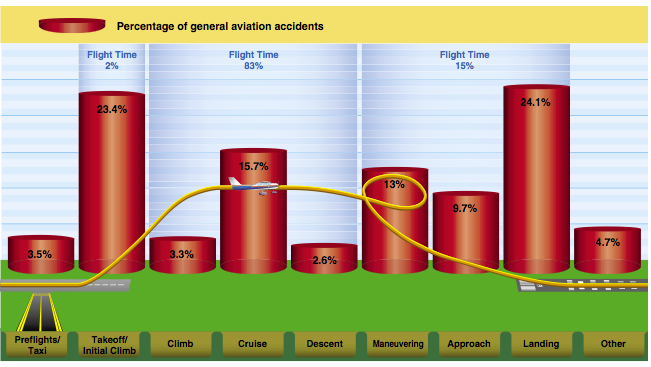
As you can see in the diagram to the left (Figure 1), the time spent in takeoff/initial climb occupy 2% of our average flight time. The time spent maneuvering, flying around the airport for the approach, and the landing itself occupy another 15%. That is 17% in total. Would it shock you to know that this mere 17% is where about 70% of the accidents happen?
Most of these accidents have a stall or spin-entry component, or both. While it is true that having better stick and rudder skills, better coordination skills, and a better feel for the airplane would help reduce these accidents, it is also becoming clear that distractions and decision making mistakes are a bigger factor than most would have believed.
Distractions and decision making mistakes were known by those who wrote Advisory Circular AC 61-67, which is now on version C, Change 2. That is the Advisory Circular covering “Stall and Spin Awareness Training.” This AC, as well as the guidance that directs examiners to introduce realistic distractions during check ride maneuvers, both came out of an earlier study in 1980 that showed how big a factor distractions are in maneuvering accidents.
Everyone out there should download this Advisory Circular, which can be done for free from the faa.gov website. AC 61-67 is not that big, is pretty well done, and is not that hard to read. Since the mid-90’s Spin awareness and Spin avoidance have been part of the Sport, Recreational, Private, and Commercial ACS’s or PTS’s, primarily as an oral subject. In the air, spins are not required in the flight portion of the practical, but coordination and awareness of potential stall/spin scenarios is monitored. This AC is one of the best ways to comply with these requirements.
All CFI’s should have seen AC 61-67 in the ground portion of their spin training, but many haven’t. According to Rich Stowell’s book “The Lightplane Pilot’s Guide to Stalls and Spins,” 3 safety surveys (2 in the 1990’s and one in 2005) showed that most of the CFI’s didn’t receive much ground instruction at all for their spin endorsements, and that they did not have an instructional level of knowledge about stalls and spins. Most didn’t even know AC 61-67 existed.
Paragraph 101 of AC 61-67C says “Stalls resulting from improper airspeed management are most likely to occur when the pilot is distracted by one or more other tasks, such as locating a checklist or attempting to restart after an engine failure; flying the traffic pattern on a windy day; reading a chart or making fuel and/or distance calculations; or attempting to retrieve items from the floor, back sear, or glove compartment. Pilots at all skill levels should be aware of the increased risk of entering into an inadvertent stall or spin while performing tasks that are secondary to controlling the aircraft.”
The NTSB agrees. They say that most Stall/Spin accidents occur when the pilot’s attention was diverted from flying the aircraft. They also say that 20% of Stall/Spin accidents happened after an engine failure. This is mostly because they were trying to turn back to the runway when they shouldn’t.
Most light planes are built to a 9g crash standard, so they can usually handle a crash straight ahead after engine failure.
I tell my students that a superior pilot is one who uses superior planning to avoid having to use superior ability. A superior pilot trains to have those superior abilities in their safety and maneuvering “tool bag” (the ‘knife’) but then they plot and scheme to avoid having to pull those tools out of the bag. The plotting and the scheming (alley awareness, avoidance and/or mitigation) are the important points here!
That is where we must attack the problem. Again, “what is the best way to win a knife fight in an alley?” We must learn where the alleys are, how to identify them, and how to stay out of them. Preventing the Base-to-Final Turn accident after overshooting final by going around instead of tightening the turn is a good example of avoidance.
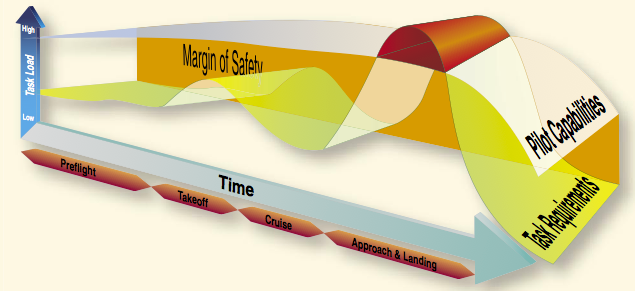
Takeoff is a bad alley that we must go through instead of avoid, so plan ahead and get through it as quickly as possible, knowing your ‘outs’ in case of possible engine failures. Awareness and mitigation of the possible threats are the keys.
In their language, what all higher agencies want pilots to do, as represented by the illustration to the left (Figure 2), is to keep the task requirements of the flight below their pilot capabilities. You can see that the takeoff and landing phases cause the highest bulges in the task requirements. We must avoid having a red overlap area, meaning we must always keep the task requirements below our pilot capabilities.
Things that would raise the task requirements to where they exceed our pilot capabilities would be things like trying to land in a crosswind that is too high for us, going to a very busy airport, flying an airplane we are unfamiliar with, etc. Things that could lower our pilot capabilities are things like being rusty, or flying when we are sick, tired, or worried.
Airlines and corporate operations have their takeoffs all planned out beforehand. Flying multi-engine airplanes, they operate under the assumption that the critical engine will be lost at the worst possible time, meaning halfway down the runway. This planning is actually required by law. V1 is the decision speed. That is when the pilot must decide to go or to stop. Look at the illustration below. (Figure 3)
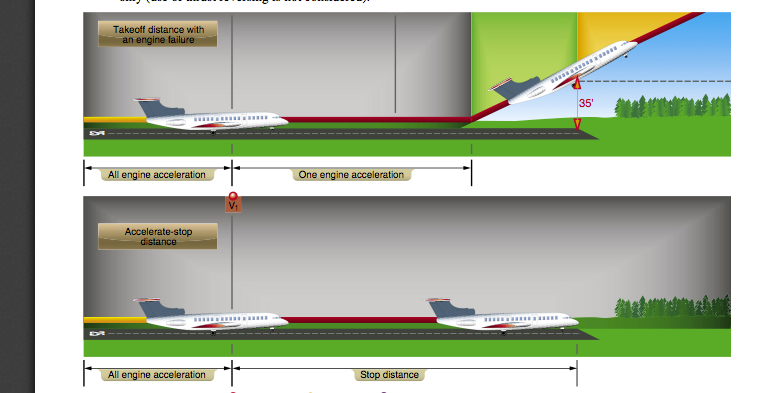
If an engine fails anytime before V1 the pilot must stop, and he or she is guaranteed to be able to stop before they run out of runway. If an engine fails at or after V1 the pilot must go, and they are guaranteed to be able to accelerate to liftoff speed, liftoff, get to 35’ by the end of the runway, and clear any obstacles. They have charts and tables for this. As the outside temp goes up the maximum weight the airplane can carry is reduced so that it can meet the above requirements. Passenger safety is guaranteed by this planning.
In General Aviation, with our single engine airplanes, where is our ‘V1’?
We can come up with our own decision points. The most important thing to stress here is the plotting and the scheming! Like the airlines and the corporate entities, let’s make the decisions on the ground even before we start the engines!
The first decision point occurs while you are in the takeoff roll. Newer airplanes have a performance section in their manuals that should be consulted. Older airplanes sometimes don’t.
In either case, though, the old rule of thumb about 70X50, or 70 by 50, works. This means you should have 70% of your takeoff speed by 50% of your runway length. 50% of the runway length is your V1, or decision point. If things aren’t going right during the takeoff, or if something just doesn’t feel right, you need enough room to cut the throttle and stop. Leave the decision too late and you’ll be in the dirt off the end of the runway, even with max braking. (Figure 5-1 below)
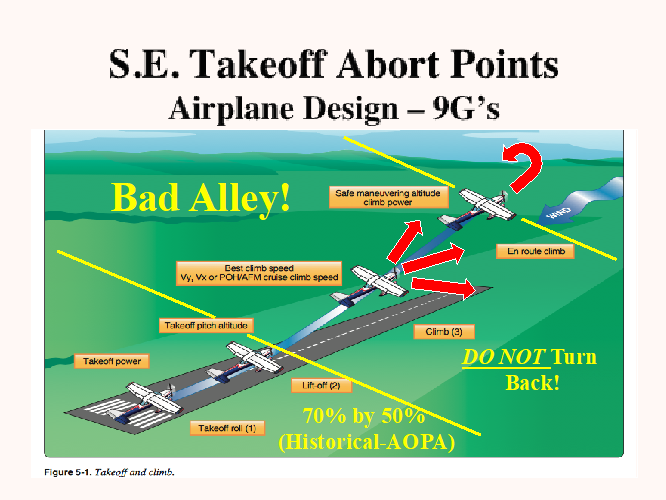
Make the decision about when and where you are going to abort before you push the throttle up. I would prefer that you make the abort point decisions before the engine is started. You can think better if you’re not doing something else. Also, get away from your passengers while you are doing your takeoff plotting and scheming.
If you have performance charts and can calculate your takeoff distance, add in a safety factor. Remember, the charts were done with a new airplane and a test pilot. They try to make allowances for average pilot technique, but add a safety factor anyway for your loved ones, OK?
Next time we’ll talk specifically about the dangers and strategies during the takeoff and the initial climb out up to the point where a safe turnaround altitude is reached.
Plot and Scheme, be decisive, and Fly Safe!!

